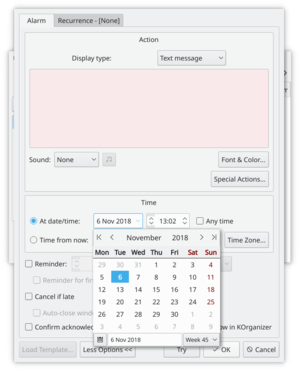KAlarm/en: Difference between revisions
(Updating to match new version of source page) |
(Importing a new version from external source) |
||
| Line 28: | Line 28: | ||
== | == More Information == | ||
* [http://www.astrojar.org.uk/kalarm/ Homepage] | * [http://www.astrojar.org.uk/kalarm/ Homepage] | ||
* [https://docs.kde.org/stable5/en/pim/kalarm/index.html KDE official documentation] | |||
[[Category:Office]] | [[Category:Office]] | ||
[[Category:Utilities]] | [[Category:Utilities]] | ||
Revision as of 20:10, 26 January 2019
| KAlarm is a personal alarm message, audio, command and email scheduler |
You can schedule alarm messages which pop up on the screen (with sound if desired), or you can schedule audio files to play, commands to be executed or emails to be sent.
When configuring an alarm, you can:
- For alarm messages, choose whether to type in your , display the , or .
- Configure the alarm to recur on , , , or basis, or set it to trigger . You can also specify a repetition within a repetition. Alarms can be constrained to occur only , or .
- Specify that a should be displayed in advance of, or after, the main alarm time(s).
- Choose a and for displaying the alarm message.
- Specify an or a to play when the message is displayed, or specify that the .
- Choose whether or not the alarm should be cancelled if it can't be triggered at its scheduled time. An alarm can only be triggered while you are logged in and running a graphical environment. If you choose not to , it will be triggered when you eventually log in.
- and more ...

It is possible to use , which for example enables you to share alarms between a laptop and desktop computer.
Alarms may also be scheduled from the command line, or via D-Bus/DCOP calls from other programs.

